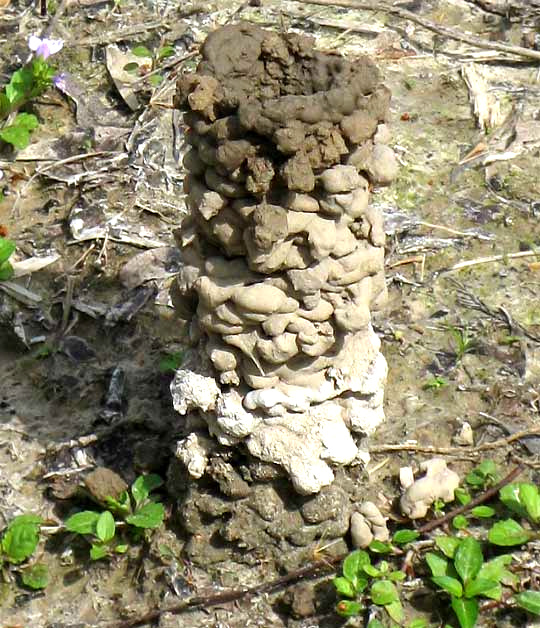Excerpts from Jim Conrad's
Naturalist Newsletter

from the March16, 2009 Newsletter, issued from the forest near Natchez, Mississippi; elevation ~400ft (120m), ~N31.47°, ~W91.29°:
"MUDBUGS"
Upland Mexico is regarded as the center of oak-tree evolution, evidenced by the large number of species present there. In the same way, the US Southeast appears to be the center of evolution for crayfish. Mississippi itself is home to about 63 species of which at least 17 are endemic. About ten Mississippi species are known but not yet given names by experts. With so many species to choose from I had no idea what might be the name of the inch-long one shown above.
Dr. Susan Adams at the USDA Forest Service Southern Research Station in Oxford, MS is a crayfish expert and she identified the picture as a PROCAMBARUS of some sort. Procambarus is the largest of Mississippi's seven crayfish genera.
The above picture was taken in a mudhole half filled with water. As I sat waiting for the frogs who had jumped into the water as I approached to reappear, the mud beside me began working as many little crayfish just like the one in the picture began emerging -- not from holes in the mud but from the mud's flat, gravy- like surface. It's hard to imagine a muddier, gummier, seemingly suffocating world, but those little critters appeared very much at home. Footprints of a large heron, probably a Great Blue, crisscrossed the mud and I visualized the bird casually stalking across the mud probing here and there with his long beak.
A few feet from the mudhole rose the mud chimney shown below:

That chimney is much too large to have been built by a crayfish as small as the one photographed, and I don't know whether the crayfish in the picture is the adult of a small species or the juvenile of a species that gets bigger. The chimney was about ten inches high and you can see that its top was darkly moist, apparently having been placed there the previous night. The lower part is older and therefore more dried out and paler. Sometimes mud chimneys display variously colored mud layers because as the crayfish digs deeper different colored soil is passed through. Crayfish dig up to three feet deep and more. Sometimes a chimney rises above a single burrow that goes straight down but more often the main tunnel has a couple of side tunnels, each with a room at the end. Often you can look down a chimney and see water, for crayfish are aquatic, absorbing oxygen through interior gills.
In Mississippi some people call crayfish "mudbugs." As a kid in rural Kentucky I was taught to call them "crawdads," and we thought only people trying to act smarter than they really were used the name "crayfish." That word "crayfish," however, has honest roots. It's thought that it arose in English around 1400 from the Old French word "crevice."
The US Forest Service hosts a very nice "Mississippi Crayfishes" page produced by Dr. Adams in Oxford at https://www.srs.fs.usda.gov/crayfish/info.php.